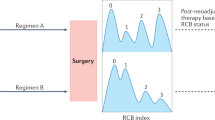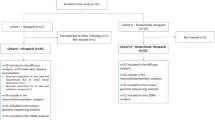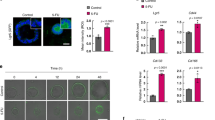Abstract
Cancer chemoprevention approaches generally use long-term, continuous treatment, which can produce major preventive effects but which can also have unexpected serious adverse events. This raises the question of whether intermittent dosing schedules might reduce toxicity while retaining benefit, a concept that we call short-term intermittent therapy to eliminate premalignancy (SITEP). Recent preclinical studies support a novel SITEP approach whereby short-term, intermittent therapy eliminates premalignant cells via apoptosis that is induced by synthetic lethal interactions. Synthetic lethality allows personalized, selective elimination of premalignant clones without harming normal cells. This Opinion article provides a detailed discussion of the principle, method and future development of the SITEP approach.
This is a preview of subscription content, access via your institution
Access options
Subscribe to this journal
Receive 12 print issues and online access
$209.00 per year
only $17.42 per issue
Buy this article
- Purchase on Springer Link
- Instant access to full article PDF
Prices may be subject to local taxes which are calculated during checkout



Similar content being viewed by others
References
Sporn, M. B., Dunlop, N. M., Newton, D. L. & Smith, J. M. Prevention of chemical carcinogenesis by vitamin A and its synthetic analogs (retinoids). Fed. Proc. 35, 1332–1338 (1976).
Goss, P. E. et al. Exemestane for breast-cancer prevention in postmenopausal women. N. Engl. J. Med. 364, 2381–2391 (2011).
Cummings, S. R. et al. Lasofoxifene in postmenopausal women with osteoporosis. N. Engl. J. Med. 362, 686–696 (2010).
Vogel, V. G. et al. Update of the national surgical adjuvant breast and bowel project study of tamoxifen and raloxifene (STAR) P-2 trial: preventing breast cancer. Cancer Prev. Res. (Phila) 3, 696–706 (2010).
Lippman, S. M. & Hawk, E. T. Cancer prevention: from 1727 to milestones of the past 100 years. Cancer Res. 69, 5269–5284 (2009).
Andriole, G. L. et al. Effect of dutasteride on the risk of prostate cancer. N. Engl. J. Med. 362, 1192–1202 (2010).
Thompson, I. M. et al. The influence of finasteride on the development of prostate cancer. N. Engl. J. Med. 349, 215–224 (2003).
Bertagnolli, M. M. et al. Celecoxib for the prevention of sporadic colorectal adenomas. N. Engl. J. Med. 355, 873–884 (2006).
Chan, A. T. et al. C-reactive protein and risk of colorectal adenoma according to celecoxib treatment. Cancer Prev. Res. (Phila) 4, 1172–1180 (2011).
Waters, E. A., Cronin, K. A., Graubard, B. I., Han, P. K. & Freedman, A. N. Prevalence of tamoxifen use for breast cancer chemoprevention among, US women. Cancer Epidemiol. Biomarkers Prev. 19, 443–446 (2010).
Freedman, A. N. et al. Benefit/Risk assessment for breast cancer chemoprevention with raloxifene or tamoxifen for women age 50 years or older. J. Clin. Oncol. 29, 2327–2333 (2011).
Theoret, M. R. et al. The risks and benefits of 5a-reductase inhibitors for prostate-cancer prevention. N. Engl. J. Med. 365, 97–99 (2011).
Meyskens, F. L. Jr et al. Regulatory approval of cancer risk-reducing (chemopreventive) drugs: moving what we have learned into the clinic. Cancer Prev. Res. (Phila) 4, 311–323 (2011).
Buchan, N. C. & Goldenberg, S. L. Intermittent androgen suppression for prostate cancer. Nature Rev. Urol. 7, 552–560 (2010).
Barnes, C. J. & Lee, M. Determination of an optimal dosing regimen for aspirin chemoprevention of 1, 2-dimethylhydrazine-induced colon tumours in rats. Br. J. Cancer 79, 1646–1650 (1999).
Primiano, T. et al. Intermittent dosing with oltipraz: relationship between chemoprevention of aflatoxin-induced tumorigenesis and induction of glutathione S-transferases. Cancer Res. 55, 4319–4324 (1995).
Rendi, M. H. et al. The selective estrogen receptor modulator arzoxifene and the rexinoid LG100268 cooperate to promote transforming growth factor beta-dependent apoptosis in breast cancer. Cancer Res. 64, 3566–3571 (2004).
Tarle, M., Spajic, B., Kraljic, I. & Kusic, Z. Continuous finasteride therapy for benign prostate hypertrophy upgrades both neuroendorcine differentiation and aggressive prostate cancer. Anticancer Res. 29, 1797–1801 (2009).
Nowell, P. C. The clonal evolution of tumor cell populations. Science 194, 23–28 (1976).
Sun, S. Y., Hail, N. Jr & Lotan, R. Apoptosis as a novel target for cancer chemoprevention. J. Natl. Cancer Inst. 96, 662–672 (2004).
William, W. N. Jr et al. High-dose fenretinide in oral leukoplakia. Cancer Prev. Res. (Phila) 2, 22–26 (2009).
Qiu, W. et al. Chemoprevention by nonsteroidal anti-inflammatory drugs eliminates oncogenic intestinal stem cells via SMAC-dependent apoptosis. Proc. Natl Acad. Sci. USA 107, 20027–20032 (2010).
Meyskens, F. L. Jr. et al. Difluoromethylornithine plus sulindac for the prevention of sporadic colorectal adenomas: a randomized placebo-controlled, double-blind trial. Cancer Prev. Res. (Phila) 1, 32–38 (2008).
Keller, J. J., Offerhaus, G. J., Hylind, L. M. & Giardiello, F. M. Rectal epithelial apoptosis does not predict response to sulindac treatment or polyp development in presymptomatic familial adenomatous polyposis patients. Cancer Epidemiol. Biomarkers Prev. 11, 670–671 (2002).
Meyskens, F. L. Jr & Gerner, E. W. Back to the future: mechanism-based, mutation-specific combination chemoprevention with a synthetic lethality approach. Cancer Prev. Res. (Phila) 4, 628–632 (2011).
Kinzler, K. W. & Vogelstein, B. Lessons from hereditary colorectal cancer. Cell 87, 159–170 (1996).
Deramaudt, T. & Rustgi, A. K. Mutant KRAS in the initiation of pancreatic cancer. Biochim. Biophys. Acta 1756, 97–101 (2005).
Herbst, R. S., Heymach, J. V. & Lippman, S. M. Lung cancer. N. Engl. J. Med. 359, 1367–1380 (2008).
Taoudi Benchekroun, M. et al. Epidermal growth factor receptor expression and gene copy number in the risk of oral cancer. Cancer Prev. Res. (Phila) 3, 800–809 (2010).
Tang, X. et al. Epidermal growth factor receptor abnormalities in the pathogenesis and progression of lung adenocarcinomas. Cancer Prev. Res. (Phila) 1, 192–200 (2008).
Sakamoto, H. et al. Disproportionate representation of KRAS gene mutation in atypical adenomatous hyperplasia, but even distribution of EGFR gene mutation from preinvasive to invasive adenocarcinomas. J. Pathol. 212, 287–294 (2007).
Howe, L. R. & Brown, P. H. Targeting the HER/EGFR/ErbB family to prevent breast cancer. Cancer Prev. Res. (Phila). 4, 1149–1157 (2011).
Dobzhansky, T. Genetics of Natural Populations. Xiii. Recombination and variability in populations of Drosophila melanogaster. Genetics 31, 269–290 (1946).
Lucchesi, J. C. Synthetic lethality and semi-lethality among functionally related mutants of Drosophila melanogaster. Genetics 59, 37–44 (1968).
Guarente, L. Synthetic enhancement in gene interaction: a genetic tool come of age. Trends Genet. 9, 362–366 (1993).
Kaelin, W. G. Jr. The concept of synthetic lethality in the context of anticancer therapy. Nature Rev. Cancer 5, 689–698 (2005).
Reinhardt, H. C., Jiang, H., Hemann, M. T. & Yaffe, M. B. Exploiting synthetic lethal interactions for targeted cancer therapy. Cell Cycle 8, 3112–3119 (2009).
Zhang, L. et al. Chemoprevention of colorectal cancer by targeting APC-deficient cells for apoptosis. Nature 464, 1058–1061 (2010).
Pitti, R. M. et al. Induction of apoptosis by Apo-2 ligand, a new member of the tumor necrosis factor cytokine family. J. Biol. Chem. 271, 12687–12690 (1996).
Wiley, S. R. et al. Identification and characterization of a new member of the TNF family that induces apoptosis. Immunity 3, 673–682 (1995).
Kelley, S. K. & Ashkenazi, A. Targeting death receptors in cancer with Apo2L/TRAIL. Curr. Opin. Pharmacol. 4, 333–339 (2004).
Sprick, M. R. et al. FADD/MORT1 and caspase-8 are recruited to TRAIL receptors 1 and 2 and are essential for apoptosis mediated by TRAIL receptor 2. Immunity 12, 599–609 (2000).
Schneider, P. & Tschopp, J. Apoptosis induced by death receptors. Pharm. Acta. Helv. 74, 281–286 (2000).
Falschlehner, C., Emmerich, C. H., Gerlach, B. & Walczak, H. TRAIL signalling: decisions between life and death. Int. J. Biochem. Cell Biol. 39, 1462–1475 (2007).
Koschny, R., Walczak, H. & Ganten, T. M. The promise of TRAIL-potential and risks of a novel anticancer therapy. J. Mol. Med. 85, 923–935 (2007).
Ashkenazi, A. et al. Safety and antitumor activity of recombinant soluble Apo2 ligand. J. Clin. Invest. 104, 155–162 (1999).
Kelley, S. K. et al. Preclinical studies to predict the disposition of Apo2L/tumor necrosis factor-related apoptosis-inducing ligand in humans: characterization of in vivo efficacy, pharmacokinetics, and safety. J. Pharmacol. Exp. Ther. 299, 31–38 (2001).
Lawrence, D. et al. Differential hepatocyte toxicity of recombinant Apo2L/TRAIL versions. Nature Med. 7, 383–385 (2001).
Herbst, R. S. et al. Phase I dose-escalation study of recombinant human Apo2L/TRAIL, a dual proapoptotic receptor agonist, in patients with advanced cancer. J. Clin. Oncol. 28, 2839–2846 (2010).
Camidge, D. R. et al. A phase I safety and pharmacokinetic study of the death receptor 5 agonistic antibody PRO95780 in patients with advanced malignancies. Clin. Cancer Res. 16, 1256–1263 (2010).
Tolcher, A. W. et al. Phase I pharmacokinetic and biologic correlative study of mapatumumab, a fully human monoclonal antibody with agonist activity to tumor necrosis factor-related apoptosis-inducing ligand receptor-1. J. Clin. Oncol. 25, 1390–1395 (2007).
Gonzalvez, F. & Ashkenazi, A. New insights into apoptosis signaling by Apo2L/TRAIL. Oncogene 29, 4752–4765 (2010).
Shirley, S. & Micheau, O. Targeting c-FLIP in cancer. Cancer Lett. 9 Nov 2010 (doi:10.1016/j.canlet.2010.10.009).
Wagner, K. W. et al. Death-receptor O-glycosylation controls tumor-cell sensitivity to the proapoptotic ligand Apo2L/TRAIL. Nature Med. 13, 1070–1077 (2007).
Bachireddy, P., Bendapudi, P. K. & Felsher, D. W. Getting at MYC through RAS. Clin. Cancer Res. 11, 4278–4281 (2005).
Huang, S., Ren, X., Wang, L., Zhang, L. & Wu, X. Lung cancer chemoprevention by induction of synthetic lethality in mutant KRAS premalignant cells in vitro and in vivo. Cancer Prev. Res. (Phila) 4, 666–673 (2011).
Luo, J. et al. A genome-wide RNAi screen identifies multiple synthetic lethal interactions with the Ras oncogene. Cell 137, 835–848 (2009).
Scholl, C. et al. Synthetic lethal interaction between oncogenic KRAS dependency and STK33 suppression in human cancer cells. Cell 137, 821–834 (2009).
Bryant, H. E. et al. Specific killing of BRCA2-deficient tumours with inhibitors of poly(ADP-ribose) polymerase. Nature 434, 913–917 (2005).
Farmer, H. et al. Targeting the DNA repair defect in BRCA mutant cells as a therapeutic strategy. Nature 434, 917–921 (2005).
Fong, P. C. et al. Inhibition of poly(ADP-ribose) polymerase in tumors from BRCA mutation carriers. N. Engl. J. Med. 361, 123–134 (2009).
Audeh, M. W. et al. Oral poly(ADP-ribose) polymerase inhibitor olaparib in patients with BRCA1 or BRCA2 mutations and recurrent ovarian cancer: a proof-of-concept trial. Lancet 376, 245–251 (2010).
Gelmon, K. A. et al. Can we define tumours that will respond to PARP inhibitors? A phase II correlative study of olaparib in advanced serous ovarian cancer and triple-negative breast cancer. J. Clin. Oncol. Abstr. 28, 3002 (2010).
Tryggvadottir, L. et al. Prostate cancer progression and survival in BRCA2 mutation carriers. J. Natl. Cancer Inst. 99, 929–935 (2007).
Polyak, K. & Garber, J. Targeting the missing links for cancer therapy. Nature Med. 17, 283–284 (2011).
Rottenberg, S. et al. High sensitivity of BRCA1-deficient mammary tumors to the PARP inhibitor AZD2281 alone and in combination with platinum drugs. Proc. Natl Acad. Sci. USA 105, 17079–17084 (2008).
Ashkenazi, A. Targeting death and decoy receptors of the tumour-necrosis factor superfamily. Nature Rev. Cancer 2, 420–430 (2002).
Abdulghani, J. & El-Deiry, W. S. TRAIL receptor signaling and therapeutics. Expert Opin. Ther. Targets. 14, 1091–1108 (2010).
Powles, T. J. Prevention of breast cancer using SERMs. Adv. Exp. Med. Biol. 630, 232–236 (2008).
Kinzler, K. W. et al. Identification of FAP locus genes from chromosome 5q21. Science 253, 661–665 (1991).
Bisgaard, M. L., Fenger, K., Bulow, S., Niebuhr, E. & Mohr, J. Familial adenomatous polyposis (FAP): frequency, penetrance, and mutation rate. Hum. Mutat. 3, 121–125 (1994).
Lynch, P. M. Chemoprevention with special reference to inherited colorectal cancer. Fam. Cancer 7, 59–64 (2008).
Wallace, M. H. & Lynch, P. M. The current status of chemoprevention in FAP. Fam. Cancer 5, 289–296 (2006).
Moser, A. R., Pitot, H. C. & Dove, W. F. A dominant mutation that predisposes to multiple intestinal neoplasia in the mouse. Science 247, 322–324 (1990).
Su, L. K. et al. Multiple intestinal neoplasia caused by a mutation in the murine homolog of the APC gene. Science 256, 668–670 (1992).
Yang, K. et al. A mouse model of human familial adenomatous polyposis. J. Exp. Zool. 277, 245–254 (1997).
Fodde, R. et al. A targeted chain-termination mutation in the mouse Apc gene results in multiple intestinal tumors. Proc. Natl Acad. Sci. USA 91, 8969–8973 (1994).
Rupnarain, C., Dlamini, Z., Naicker, S. & Bhoola, K. Colon cancer: genomics and apoptotic events. Biol. Chem. 385, 449–464 (2004).
Chan, D. A. & Giaccia, A. J. Harnessing synthetic lethal interactions in anticancer drug discovery. Nature Rev. Drug Discov. 10, 351–364 (2011).
Acknowledgements
This work is supported in part by a CPRIT grant RP110107 to X.W. and the institutional core/CCSG grant 5P30 CA-16672-36 from US NIH/NCI.
Author information
Authors and Affiliations
Corresponding author
Ethics declarations
Competing interests
The authors declare no competing financial interests.
Rights and permissions
About this article
Cite this article
Wu, X., Lippman, S. An intermittent approach for cancer chemoprevention. Nat Rev Cancer 11, 879–885 (2011). https://doi.org/10.1038/nrc3167
Published:
Issue Date:
DOI: https://doi.org/10.1038/nrc3167
This article is cited by
-
Synergistic effect of TRAIL and irradiation in elimination of glioblastoma stem-like cells
Clinical and Experimental Medicine (2018)
-
Synthetic lethality and cancer
Nature Reviews Genetics (2017)
-
Cancer chemoprevention: a rapidly evolving field
British Journal of Cancer (2013)



